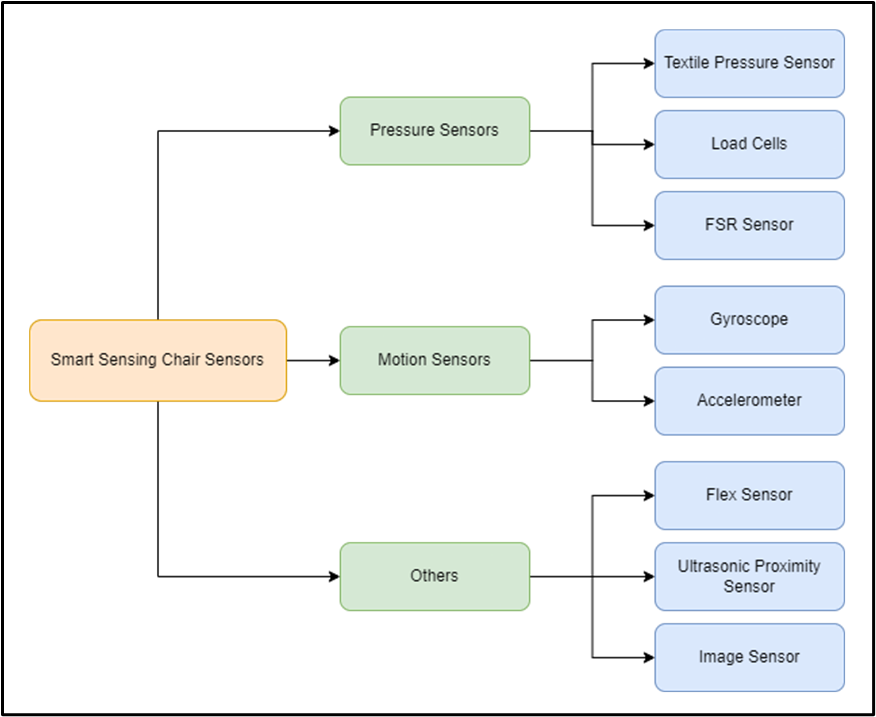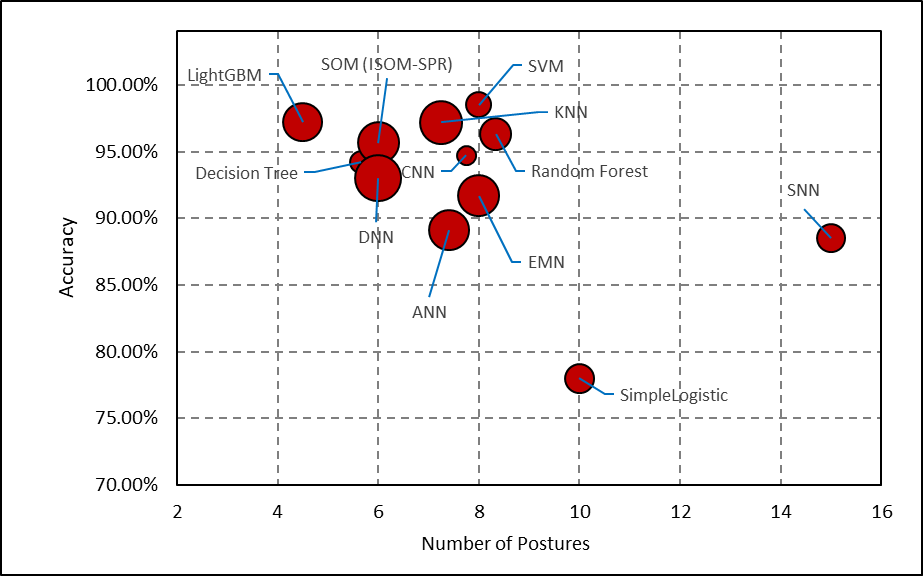Smart sensing chairs, equipped with advanced sensor technologies such as Force Sensing Resistors (FSRs), show significant potential in mitigating the negative health impacts of incorrect sitting postures, which can lead to spinal misalignment and musculoskeletal disorders. Research emphasizes the use of sophisticated machine learning techniques, including Convolutional Neural Networks (CNNs) and Artificial Neural Networks (ANNs), for classifying sitting postures. Notably, these advanced models do not always outperform traditional models due to the limitations of the training datasets, which often lack sufficient diversity in representing different human body types and health conditions. This finding underscores the critical need for datasets that more accurately reflect the demographic and physiological diversity of users. Additionally, this research highlights a significant opportunity for innovation in user feedback mechanisms within smart sensing chairs, suggesting that enhanced interactive features could improve posture correction efforts and overall user health outcomes.
- smart-sensing chair
- musculoskeletal disorders
- sitting posture classification
- Artificial Intelligence
1. Introduction
In 2020, musculoskeletal disorders (MSDs) were the second leading cause of non-fatal disability worldwide, impacting over a billion people and costing the UK alone more than GBP 4.1 billion annually. Across the European Union, MSDs consume about 2% of GDP, roughly EUR 240 billion each year [1]. Despite common misconceptions, MSDs affect individuals of all ages, often exacerbated by sedentary lifestyles and poor posture in office settings. Prolonged sitting is strongly linked to severe back pain and spinal deformities[2]. To mitigate these risks, regular breaks and exercise are recommended to enhance cognitive and muscle functions.
Poor sitting posture not only contributes to back pain but also to the development of pressure sores in wheelchair users, complicating their comfort and mobility. Traditional postural assessments, often subjective and performed in clinical settings, rely on visual inspection, palpation, or impractical and costly methods like MRI and CT scans. Both contact and non-contact methods [3] for postural assessment have limitations [4], including discomfort, lack of 3D data [5] and the need for an upright position during measurements[6].
Smart sensing chairs, integrating sensors within the seating area, offer a practical solution by enabling continuous, real-time posture monitoring without the constraints of traditional methods. These chairs are increasingly being incorporated into both home and office environments, offering potential improvements in personalized healthcare for those with MSDs.
2. Correct Sitting Posture
The idea of an "ideal" sitting posture varies widely, especially for those with permanent mobility impairments or wheelchair users. Traditional views recommend an upright lordotic spinal position, but the variability in spinal anatomy challenges this one-size-fits-all approach [7]. Biomechanical research shows that extended sitting, particularly in slumped positions, exacerbates musculoskeletal disorders and contributes to lower back pain. Recommendations advise against prolonged sitting in any posture to reduce health risks. Research indicates no conclusive evidence that any specific sitting posture significantly enhances health benefits. A numerous studies using smart sensing chairs identified the most common sitting postures, including upright with backrest, slouching forward, and leaning in various directions, showing the diverse ways people sit and the pressure points involved.
3. Sensors
Smart sensing chairs incorporate a variety of sensor technologies, each uniquely tailored to enhance the monitoring and classification of sitting postures, a crucial element in preventing musculoskeletal disorders. Among these technologies, Force Sensing Resistors (FSRs) are prominent due to their cost-effectiveness and ease of integration [8]. FSRs measure the force exerted on surfaces, adjusting their output resistance accordingly, though they are prone to drift errors that can affect accuracy, necessitating periodic recalibrations.
Textile pressure sensors represent another innovative approach, weaving conductive threads into fabrics to create sensors that are both durable and comfortable [9]. These sensors are particularly advantageous in wearable technologies, offering seamless integration and minimal disruption to the user. Unlike FSRs, they provide a more user-friendly option without compromising on sensor responsiveness. Load cells, which convert applied forces into digital signals, offer a higher precision in posture classification, though their use in smart chair technologies is less common. This may be due to the bulkier setup and higher costs compared to more streamlined options like FSRs. Flex sensors, or bend sensors, measure the amount of bending or displacement and are versatile in applications ranging from medical devices to robotics [10]. Their use in smart chairs is based on their ability to detect subtle posture changes, though they are not as commonly employed as pressure-based sensors. Image-based sensors, which include cameras and 3D image capturing devices, introduce a high-tech method of posture classification using computer vision algorithms. While offering detailed visual data, their application is less frequent due to variability in accuracy and the complexity of integrating such systems into everyday seating arrangements. In terms of sensor placement strategies, research has explored both dense and sparse sensor configurations. Dense configurations typically involve a mat of interconnected sensors covering a large area, which can more accurately map pressure distribution and detect subtle shifts in posture. In contrast, sparse sensor configurations use fewer sensors placed at strategic points, which can be sufficient for basic posture detection but may miss finer nuances compared to their dense counterparts. Figure 1 shows the categories of sensors being used by researchers in the classification of sitting postures.

Figure 1. Taxonomy graph of sensors used in smart sensing chair systems.
Integration with the Internet of Things (IoT) represents a forward-thinking approach to health monitoring in smart chairs [11]. By connecting sensors to the internet, these systems can offer real-time health data analysis, potentially reducing healthcare costs through early detection and intervention. Despite the advanced technology in detection and classification, many smart sensing chairs still lack comprehensive feedback mechanisms. While approximately 36% of systems incorporate some form of user alert, such as mobile or desktop applications or even haptic feedback, there is significant room for improvement in making these alerts more intuitive and less intrusive.
Overall, the selection of sensor technology in smart sensing chairs significantly impacts their effectiveness and user experience, highlighting a trade-off between accuracy, cost, integration complexity, and user comfort. As the field evolves, the challenge remains to balance these factors to optimize both posture correction and user satisfaction.
4. Algorithms
Smart sensing chairs employ various techniques and machine learning algorithms for posture detection, ranging from rule-based systems to advanced neural networks. Rule-based systems, using predefined if-else conditions, offer transparency and low computational demand, making them suitable for real-time applications [12]. However, their simplicity can be a drawback as they struggle with the complexity of varied postural transitions and scalability in diverse settings like healthcare.
Statistical models like K-Nearest Neighbors, Decision Trees, and Support Vector Machines strike a balance between complexity and performance, efficiently handling posture classification with less computational intensity [13]. These models are adaptable to embedded systems in smart chairs but must be carefully selected to match the data characteristics and functional demands of the system.
Deep learning models, including Convolutional and Artificial Neural Networks, are favored for their robust pattern recognition capabilities, crucial for analyzing spatial pressure distributions [14]. These models excel in processing large datasets and automatic feature extraction but require extensive, diverse training data to avoid biases and ensure generalizability. Despite their effectiveness, the opaque nature of these 'black box' models can be problematic in medical settings where decision-making transparency is essential. Figure 2 indicates that deep learning models, do not significantly outperform traditional statistical models in terms of classification accuracy for sitting posture detection.

Figure 2. Comparison of machine learning models: number of postures vs. accuracy vs. test subjects, as indicated by the size of the circle.
5. Conclusions
The discussion on smart sensing chairs reveals that pressure sensors, especially Force Sensing Resistors (FSRs), are commonly preferred for classifying sitting postures due to their efficacy and cost-effectiveness. Although individual sensor placement is favored over dense arrays for maintenance and cost efficiency, the choice of sensor setup does not necessarily correlate with higher classification accuracy.
Studies incorporating multiple sensor types, such as combining pressure sensors with infrared or ultrasonic sensors, have shown improved accuracy in detecting a wide range of sitting postures. This method not only enhances posture classification but also supports continuous health monitoring, although it increases system complexity and cost. The integration of multiple sensors, while beneficial, also raises challenges in data fusion and privacy concerns due to the sensitive nature of collected data.
Machine learning models used in these systems show that more complex models do not always yield better results, especially when limited by the size and diversity of training datasets. Most systems focus on a select number of postures to maintain high accuracy, highlighting a trade-off between the number of postures detected and the precision of classification.
Despite technological advances, there is a notable gap in user feedback evaluation, with few studies assessing the effectiveness of feedback mechanisms in promoting correct sitting postures. Future research should address this by developing and rigorously testing user feedback systems to enhance real-world applicability and user engagement.
In conclusion, while smart sensing chairs show potential in enhancing posture and reducing musculoskeletal disorders, their real-world implementation faces hurdles such as user adoption, data privacy, and integration with existing technological infrastructures. Future research should explore diverse and extensive datasets to train models that are truly reflective of the general population and further investigate the integration of various sensor types to optimize chair functionality and user health outcomes.
References
- Tiffany K Gill; Manasi Murthy Mittinty; Lyn M March; Jaimie D Steinmetz; Garland T Culbreth; Marita Cross; Jacek A Kopec; Anthony D Woolf; Lydia M Haile; Hailey Hagins; et al. Global, regional, and national burden of other musculoskeletal disorders, 1990–2020, and projections to 2050: a systematic analysis of the Global Burden of Disease Study 2021. Lancet Rheumatol. 2023, 5, e670-e682, .
- Caroline Collange; Marie-Anne Burde; Musculoskeletal problems of neurogenic origin. Best Pr. Res. Clin. Rheumatol. 2000, 14, 325-343, .
- Adam Partlow; Colin Gibson; Janusz Kulon; Ian Wilson; Steven Wilcox; Pelvis feature extraction and classification of Cardiff body match rig base measurements for input into a knowledge-based system. J. Med Eng. Technol. 2012, 36, 399-406, .
- Larie E Amendt; Kristen L Ause-Ellias; Julie Lundahl Eybers; Carolyn T Wadsworth; David H Nielsen; Stuart L Weinstein; Validity and Reliability Testing of the Scoliometer®. Phys. Ther. 1990, 70, 108-117, .
- Adam Partlow; Colin Gibson; Janusz Kulon; 3D posture visualisation from body shape measurements using physics simulation, to ascertain the orientation of the pelvis and femurs in a seated position. Comput. Methods Programs Biomed. 2020, 198, 105772, .
- Janusz Kulon; Michael Voysey; Adam Partlow; Paul Rogers; Colin Gibson. Development of a system for anatomical landmarks localization using ultrasonic signals; Institute of Electrical and Electronics Engineers (IEEE): Piscataway, NJ, United States, 2016; pp. 1-6.
- Diane Slater; Vasileios Korakakis; Peter O'Sullivan; David Nolan; Kieran O'Sullivan; “Sit Up Straight”: Time to Re-evaluate. J. Orthop. Sports Phys. Ther. 2019, 49, 562-564, .
- Leonel Paredes-Madrid; Carlos A. Palacio; Arnaldo Matute; Carlos A. Parra Vargas; Underlying Physics of Conductive Polymer Composites and Force Sensing Resistors (FSRs) under Static Loading Conditions. Sensors 2017, 17, 2108, .
- Francisco Pizarro; Piero Villavicencio; Daniel Yunge; Mauricio Rodríguez; Gabriel Hermosilla; Ariel Leiva; Easy-to-Build Textile Pressure Sensor. Sensors 2018, 18, 1190, .
- Giovanni Saggio; Francesco Riillo; Laura Sbernini; Lucia Rita Quitadamo; Resistive flex sensors: a survey. Smart Mater. Struct. 2015, 25, 013001, .
- Abderahman Rejeb; Karim Rejeb; Horst Treiblmaier; Andrea Appolloni; Salem Alghamdi; Yaser Alhasawi; Mohammad Iranmanesh; The Internet of Things (IoT) in healthcare: Taking stock and moving forward. Internet Things 2023, 22, 100721, .
- Janusz Kulon; Adam Partlow; Colin Gibson; Ian Wilson; Steven Wilcox; Rule-based algorithm for the classification of sitting postures in the sagittal plane from the Cardiff Body Match measurement system. J. Med Eng. Technol. 2013, 38, 5-15, .
- Leonor Pereira; Hugo Plácido da Silva; A Novel Smart Chair System for Posture Classification and Invisible ECG Monitoring. Sensors 2023, 23, 719, .
- Tariku Adane Gelaw; Misgina Tsighe Hagos. Posture Prediction for Healthy Sitting Using a Smart Chair; Springer Science and Business Media LLC: Dordrecht, GX, Netherlands, 2022; pp. 401-411.
